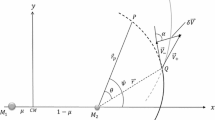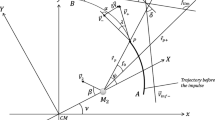Abstract
The present paper studies the effects of a powered Swing-By maneuver, considering the particular and important situations where there are energy gains for the spacecraft. The objective is to map the energy variations obtained from this maneuver as a function of the three parameters that identify the pure gravity Swing-By with a fixed mass ratio (angle of approach, periapsis distance and velocity at periapsis) and the three parameters that define the impulsive maneuver (direction, magnitude and the point where the impulse is applied). The mathematical model used here is the version of the restricted three-body problem that includes the Lemaître regularization, to increase the accuracy of the numerical integrations. It is developed and implemented by an algorithm that obtains the energy variation of the spacecraft with respect to the largest primary of the system in a maneuver where the impulse is applied inside the sphere of influence of the secondary body, during the passage of the spacecraft. The point of application of the impulse is a free parameter, as well as the direction of the impulse. The results make a complete map of the possibilities, including the maximum gains of energy, but also showing alternatives that can be used considering particularities of the mission.













Similar content being viewed by others
References
Prado, A.F.B.A.: Powered Swing-By. J. Guid. Control Dyn. 19(5), 1142–1147 (1996)
Da Silva Ferreira, A.F., Prado, A.F.B.A., Winter, O.C.: A numerical study of powered Swing-Bys around the Moon. Adv. Space Res. 56(2), 252–272 (2015)
Araujo, R.A.N., Winter, O.C., Prado, A.F.B.A., Vieira Martins, R.: Sphere of influence and gravitational capture radius: a dynamical approach. Mon. Not. R. Astron. Soc. 391(2), 675–684 (2008)
Casalino, L., Colasurdo, G., Pastrone, D.: Simple strategy for powered Swing-By. J. Guid. Control Dynam. 22(1), 156–159 (1999)
Uphoff, C.: The art and science of lunar gravity assist In: AAS/GSFC Symposium, (1989). (AAS 89-170)
Nock, K.T., Upholf, C.W.: Satellite aided orbit capture (1979). (AAS/AIAA paper 79-165)
Flandro, G.: Fast reconnaissance missions to the outer solar system utilizing energy derived from the gravitational field of jupiter. Astronaut. Acta 12(4), 329–337 (1966)
Kohlhase, C.E., Penzo, P.A.: Voyager mission description. Sp. Sci. Rev. 21(2), 77–101 (1977)
Byrnes, D.V., D’amario, L.A.: A combined Halley flyby Galileo mission. AIAA/AAS Astrodynamics Conference, San Diego, CA, AIAA paper 82-1462 (1982)
Dunham, D., Davis, S.: Optimization of a multiple Lunar-Swingby trajectory sequence. J. Astronaut. Sci. 33(3), 275–288 (1985)
Carvell, R.: Ulysses-the Sun from above and below. Space 1, 18–55 (1985)
Broucke, R.A., Prado, A.F.B.A.: Planar close encounter trajectories for spacecraft passing near Jupiter. Adv. Sp. Res. 36(3), 561–568 (2005)
Prado, A.F.B.A., Broucke, R.A.: Júpiter Swing-By trajectories passing near the Earth. Adv. Astronaut. Sci. 82(Part 2), 1159–1176 (1993). (AAS—AIAA Spaceflight Mechanics Meeting, 3, 22–24)
Prado, A.F.B.A., Broucke, R.A.: A classification of Swing-By trajectories using the Moon. Appl. Mech. Rev. 48(11), 138–142 (1995)
Sukhanov, A.: Close approach to sun using gravity assists of the inner planets. Acta Astronaut. 45(4–9), 177–185 (1999)
Casalino, L., Colasurdo, G., Pasttrone, D.: Optimal low-thrust scape trajectories using gravity assist. J. Guid. Control Dyn. 22(5), 637–642 (1999)
Longuski, J.M., Strange, N.J.: Graphical method for gravity-assist trajectory design. J Spacecr. Rockets 39(1), 9–16 (2002)
McConaghy, T.T., Debban, T.J., Petropulos, A.E., Longuski, J.M.: Design and optimization of low-thrust gravity trajectories with gravity assist. J Spacecr. Rockets 40(3), 380–387 (2003)
Heaton, A.F., Strange, N.J., Longuski, J.M.: Automated design of the Europa orbiter tour. J Spacecr. Rockets 39(1), 17–22 (2002)
Longman, R.W., Schneider, A.M.: Use of Jupiter’s moons for gravity assist. J Spacecr. Rockets 7(5), 570–576 (1970)
Lynam, A.E., Kloster, K.W., Longuski, J.M.: Multiple-satellite-aided capture trajectories at Jupiter using the Laplace resonance. Celest. Mech. Dyn. Astron. 109, 59–84 (2011)
Longuski, J.M., Williams, S.N.: The last grand tour opportunity to Pluto. J. Astronaut. Sci. 39, 359–365 (1991)
Hollister, W.M., Prussing, J.E.: Optimum transfer to Mars via Venus. Astronaut. Acta 12(2), 169–179 (1966)
Striepe, S.A., Braun, R.D.: Effects of a Venus Swing-By periapsis burn during an Earth–Mars trajectory. J. Astronaut. Sci. 39(3), 299–312 (1991)
Muhonen, D., Davis, S., Dunham, D.: Alternative gravity-assist sequences for the ISEE-3 escape trajectory. J. Astronaut. Sci. 33(3), 255–273 (1985)
Broucke, R.A.: The celestial mechanics of gravity assist. AIAA/AAS Astrodynamics Conference, Minneapolis, MN, AIAA paper 88-4220 (1988)
Araujo, R.A.N., Winter, O.C., Prado, A.F.B.A.: The Swing-By effect in the Vesta-Magnya case. Single and multiple encounters. WSEAS Trans. Syst. 11(6), 187–197 (2012)
Okutsu, M., Yam, C.H., Longuski, J.M.: Low-thrust trajectories to jupiter via gravity assists from Venus, Earth and Mars. AIAA/AAS Astrodynamics Specialist Conference, Keystone, CO, AIAA Paper 2006-6745 (2006)
Santos, D.P.S., Prado, A.F.B.A., Casalino, L., Colasurdo, G.: Optimal trajectories towards near-earth-objects using solar electric propulsion (sep) and gravity assisted maneuver. J. Aerosp. Eng. 1(2), 51–64 (2008)
McNutt Jr., R.L., Solomon, S.C., Grard, R., Novara, M., Mukai, T.: An international program for mercury exploration: synergy of messenger and bepicolombo. Adv. Sp. Res. 33(12), 2126–2132 (2004)
McNutt Jr., R.L., Solomon, S.C., Gold, R.E., Leary, J.C.: The messenger mission to mercury: development history and early mission status. Adv. Sp. Res. 38(4), 564–571 (2006)
Grard, R.: Mercury: the messenger and bepicolombo missions a concerted approach to the exploration of the planet. Adv. Sp. Res. 38(4), 563 (2006)
Jehn, R., Companys, V., Corral, C., Yárnoz, D.G., Sánchez, N.: Navigating BepiColombo during the weak-stability capture at Mercury. Adv. Sp. Res. 42(8), 1364–1369 (2008)
Gomes, V.M., Prado, A.F.B.A.: Swing-by maneuvers for a cloud of particles with planets of the solar system. WSEAS Trans. Appl. Theor. Mech. 3(11), 869–878 (2008)
Gomes, V.M., Formiga, J., de Moraes, R.V.: Studying close approaches for a cloud of particles considering atmospheric drag. Math. Probl. Eng. (2013). doi:10.1155/2013/468624
Gomes, V.M., Prado, A.F.B.A.: A study of the impact of the initial energy in a close approach of a cloud of particles. WSEAS Trans. Math. 9, 811–820 (2010)
Murray, C.D., Dermott, S.F.: Solar System Dynamics, 1st edn. Cambridge University Press, Cambridge (1999)
Szebehely, V.: Theory of Orbits. Academic Press, New York (1967)
Pourtakdoust, S.H., Sayanjali, M.: Fourth body gravitation effect on the resonance orbit characteristics of the restricted three-body problem. Nonlinear Dyn. 76(2), 955–972 (2014)
Zotos, E.E.: Classifying orbits in the restricted three-body problem. Nonlinear Dyn. 82(3), 1233–1250 (2015)
Qian, Y.J., Zhang, W., Yang, X.D., Yao, M.H.: Energy analysis and trajectory design for low-energy escaping orbit in Earth–Moon system. Nonlinear Dyn 85(1), 463–478 (2016)
Vieira Neto, E., Winter, O.C.: Time analysis for temporary gravitational capture: satellites of Uranus. Astron. J. 122(1), 440–448 (2001)
Acknowledgements
The authors wish to express their appreciation for the support provided by Grants # 304700/2009-6 from the National Council for Scientific and Technological Development (CNPq); Grants # 2011/08171-3 and 2014/06688-7, from São Paulo Research Foundation (FAPESP) and the financial support from the National Council for the Improvement of Higher Education (CAPES).
Author information
Authors and Affiliations
Corresponding author
Appendices
Appendix 1: Detailed information about the trajectories in the Earth–Moon system
It is shown here the maximum energy variations \((\Delta E_{\max })\) and its corresponding data, as the true anomaly of the point where the impulse is applied \((\theta )\), the angle that gives the direction of the impulse \((\alpha )\), the deflection angle \((\zeta )\), the escape velocity \((V_{\infty +})\) and R, which is the distance between the spacecraft and the secondary body at the instant that the impulse is applied.
Appendix 2: Details of the trajectories for the Sun–Jupiter system
It is shown here the maximum energy variations \((\Delta E_{\max })\) and its corresponding data, as the true anomaly of the point where the impulse is applied \((\theta )\), the angle that gives the direction of the impulse \((\alpha )\), the deflection angle \((\zeta )\), the escape velocity \((V_\infty +)\) and R, which is the distance between the spacecraft and the secondary body at the instant that the impulse is applied.
Appendix 3: Coefficients of the empirical equations that describe the maximum energy variation
Equations (24) and (28) describe the coefficients of Eq. 20 as a function of the magnitude of the impulse \((\delta {V})\).
Equations (29) and (33) describe the coefficients of Eq. (21) as a function of the magnitude of the impulse \((\delta {V})\).
Equations (34) and (44) describe the coefficients of Eq. (22) as a function of the magnitude of the impulse \((\delta {V})\).
Equations (45) and (55) describe the coefficients of Eq. (23) as a function of the magnitude of the impulse \((\delta V)\).
Rights and permissions
About this article
Cite this article
Ferreira, A.F.S., Prado, A.F.B.A. & Winter, O.C. A numerical mapping of energy gains in a powered Swing-By maneuver. Nonlinear Dyn 89, 791–818 (2017). https://doi.org/10.1007/s11071-017-3485-2
Received:
Accepted:
Published:
Issue Date:
DOI: https://doi.org/10.1007/s11071-017-3485-2




